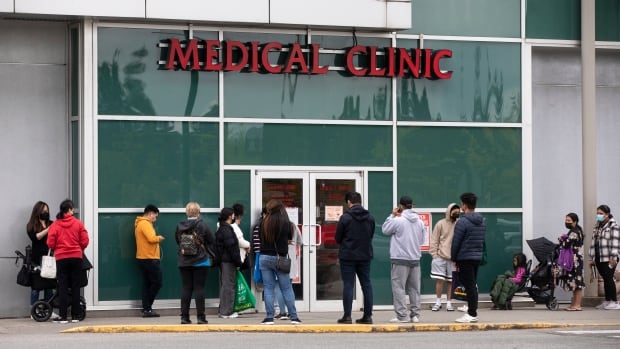Family doctors are often the first place Canadians turn for medical care, but the proportion of adults with access to a primary care provider has declined, a new survey suggests.
The international survey was conducted in 10 high-income countries by the Commonwealth Fund, a U.S.-based non-profit foundation that funds surveys of patients and health-care providers in multiple countries. A partner, the Canadian Institute for Health Information, released the findings on Thursday.
More than 4,500 Canadians were asked if they had a regular doctor or place of care, which may include a physician or a general health-care clinic and excludes emergency visits and hospital care.
Lack of access to a primary care provider negatively impacts the health of both individuals and the population, the institute said.
“The percentage of Canadians who reported having a regular doctor or place that they go for care dropped from 93 per cent in 2016 to 86 per cent in 2023,” said Cheryl Chui, director of health system analytics at CIHI in Toronto, in an interview.
In comparison, 93 per cent of adults in peer countries have a doctor or place they usually go to for medical care.
Respondents were also asked how difficult is was to get same- or next-day medical appointments. The 2023 results showed that Canadians are still struggling with timely access to primary care, Chui said.
Variations and possible inequity in access
The researchers at CIHI found that not having a primary care provider was more common among Canadians with lower levels of household income, younger adults from 18 to 34 and men.
Chui said they’re seeing variation and maybe inequities in the data. Why isn’t known, but geography could also play a role.
About 93 per cent of those earning more than $150,000 a year reported having a regular primary care provider such as a family physician or nurse practitioner. For those with a household income under $30,000, 81 per cent said they did.
Dr. David Barber, who chairs the section on general and family practice at the Ontario Medical Association, said primary care has often been shown in research studies to be the most important factor when it comes to people leading healthier and longer lives.
The federal government is striking deals with provinces and pledging billions of dollars to help solve Canada’s family doctor shortage, but experts say it’s not enough to address the situation for millions of patients without a primary physician.
But primary care isn’t prioritized by governments, he said.
“It seems that the hospitals tend to run the show, and that’s where the money goes.”
Barber said other wealthy countries are spending 50 per cent more on primary care than Canada.
Barber fears staffing problems in family medicine will only get worse, pointing to Wednesday’s results of the Canadian Residency Matching Service (CaRMS), which matches medical school graduates with program placements across the country.
Ontario represents 40 per cent of the Canadian population, Barber said, and there were 116 unfilled family medicine spots in the province alone — that’s almost half of Canada’s unfilled family medicine placements — up from 103 unclaimed spots last year.
The CIHI researchers also looked at other aspects of primary care, such as how the cost of prescriptions impacted Canadian respondents.
According to the survey, just over 10 per cent of Canadian respondents said that during the past year, they had either not filled a prescription or skipped doses of their medications due to the cost.
Dr. Nav Persaud, who holds the Canada Research Chair in Health Justice at the University of Toronto, said the responses regarding not filling prescriptions because of cost is in line with other studies.
“Through seeing a family doctor, you might find out whether or not abdominal pain is due to cancer or indigestion,” Persaud said, noting that’s not something he wants people trying to guess about.
“What no one wants is for someone to be debating at home whether or not they should visit the emergency room or a walk-in clinic because they have poor access to care, and then later find out that it would have been better if they had been seen sooner.”
CIHI’s team also found more Canadians were worried about housing and food security compared to the average among people in other high-income nations.
In Canada, 17 per cent of people surveyed said they were worried about being able to pay their rent or mortgage, compared to an average of 14 per cent across the 10 countries.
About 10 per cent of Canadians worried about having enough food or a clean, safe place to sleep, compared with an average of eight per cent across the 10 countries.








